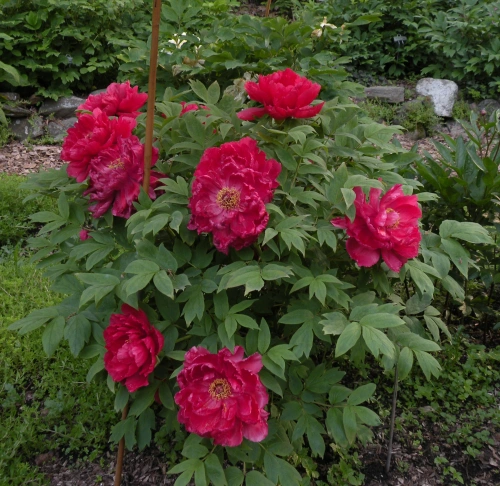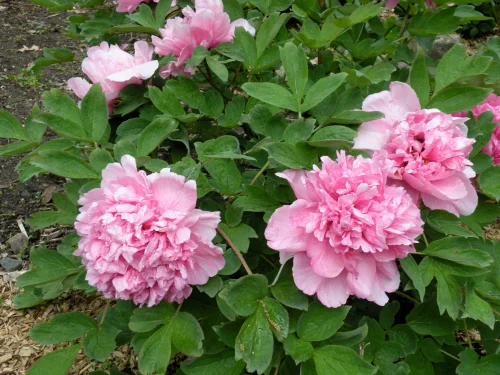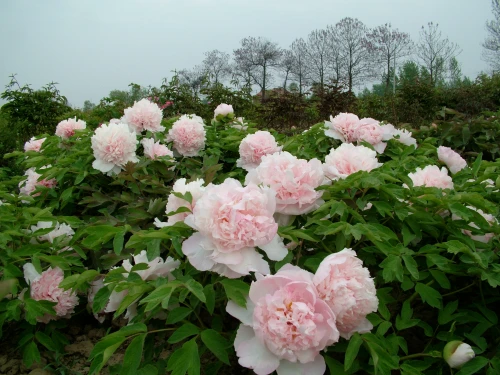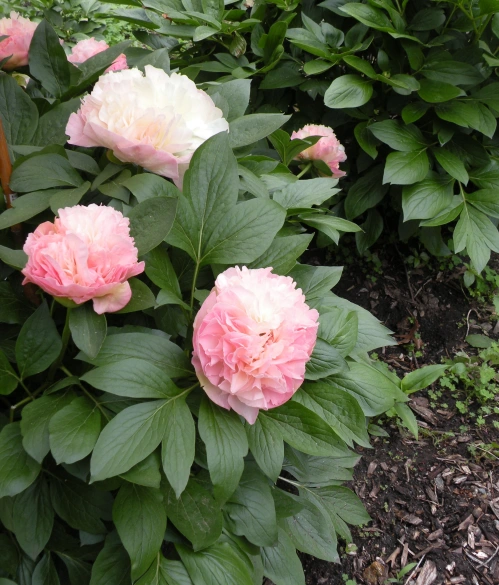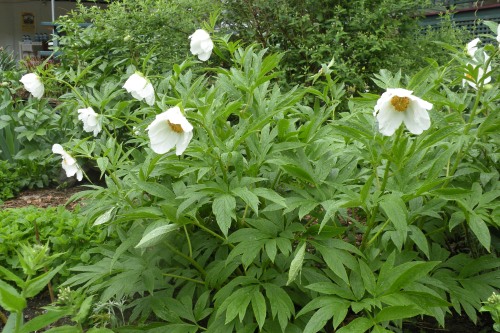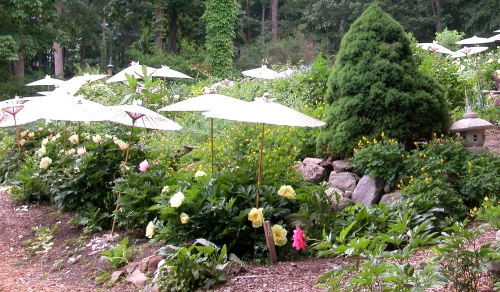Peony Growth Habits: a peony for every place
Among the three types of peonies- tree, herbaceous and intersectional, there are a variety of growth habits. Along with sun requirements, the mature form of a given variety is an important consideration when planning to add a peony to your garden.
Tree peonies, like other woody perennials, are comprised of a thicket of stems which emerge out of the ground from the root system. Tree peony growth habits are categorized according to the angle at which the branches grow relative to the ground.
Upright form tree peonies
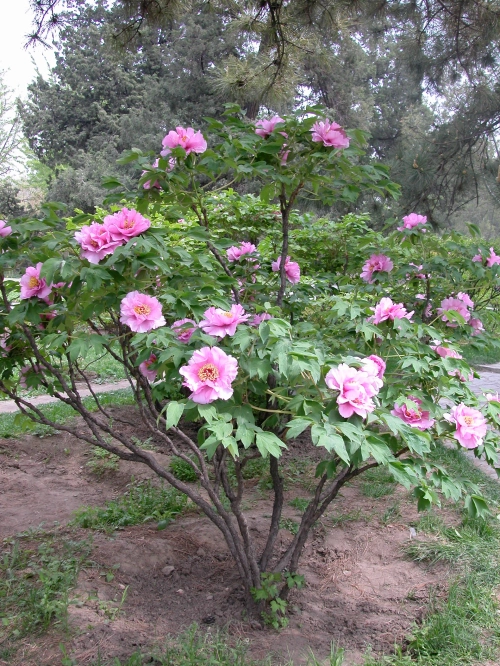
Upright form tree peony Sichuan Peach Blossom, blooming in Beijing, China. Note how the lower leaf growth has been removed so the majestic woody structure of the plant is clearly visible.
Upright form tree peonies tend to be vigorous varieties with comparatively long annual growth. Stems and branches grow upwards, at a narrow angle to the ground. The example shown here ( Sichuan Peach Blossom) is about 6 ft. tall and 6 ft. wide, and has been pruned of lower leaves and small branches to allow an uncluttered, open form of the shrub.
Tree peonies with this growth habit include: most cultivars in the Chinese rockii and Japanese groups, some Central Plains Chinese and hybrid tree peonies. Final mature height will vary between 4.5 to 7 ft., depending on the cultivar. In our plant descriptions, we do include the mature height of our cultivars.
Landscape uses: Tree peonies with upright growth habits make excellent display plants. Do not be intimidated by the height, keep in mind that tree peonies are slow growing plants which take 10-15 years to reach their mature size. Vigorous cultivars can also be kept smaller with yearly pruning. Grow in USDA zones 4-9, with at least 5-6 hours of sunlight.
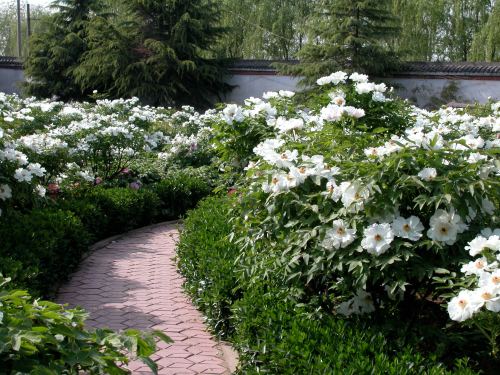
Phoenix White 风丹白 Feng Dan Bai Chinese tree peony
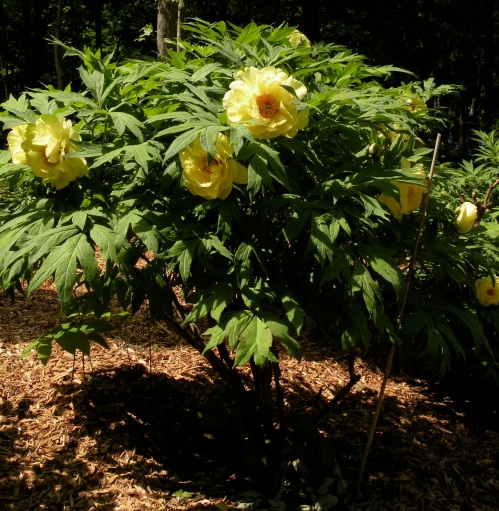
High Noon hybrid American tree peony
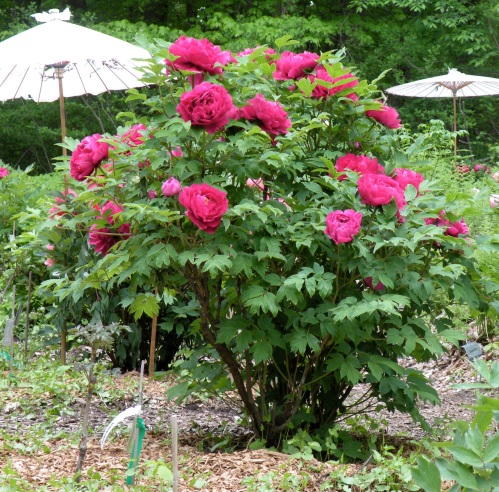
Luoyang Red 洛阳红 Luo Yang Hong Chinese tree peony. This plant would be well served with a pruning to remove some of the interior, crowded growth.
Spreading form tree peonies
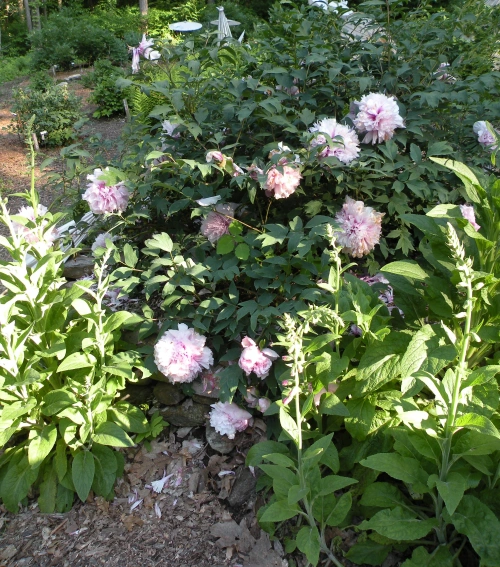
Color of Eternity 万世生色 Wan Shi Sheng Se is a good example of a spreading form tree peony.
The branches of the spreading form tree peonies expand out diagonally to the ground, so that the plant width is much greater than the height. This type seems slower growing than upright habit tree peonies. At maturity, tree peonies with spreading growth habit measure between 2.5-3 ft. tall and 3-5 ft. wide.
Tree peonies with this growth habit include: Some Central Plains cultivar group of Chinese tree peonies (includes many of the historic Chinese varieties), some hybrid tree peonies.
Landscape placement: Mixed perennial border or foundation planting. Also very attractive planted on a raised terrace which allows for easy viewing of downward facing flowers. Ideal for smaller gardens. Grow in USDA zones 4-9, with at least 5-6 hours of sunlight.
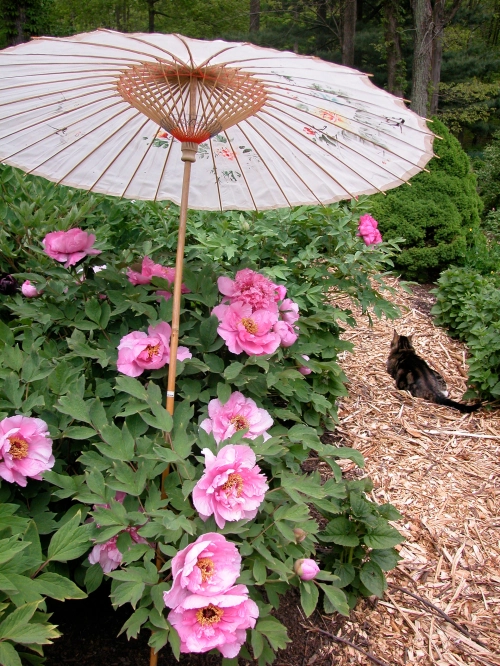
Peach Blossom Complexion 粉面桃花 Fen Mian Tao Hua Chinese tree peony
Semi-spreading form tree peonies

Gold Sand in a Black Ocean 黑海撒金 Hei Hai Sa Jin is a Chinese tree peony with a semi-spreading form.
The semi-spreading growth habit is characterized as being an intermediate between the upright and the spreading types. Typically dimensions at maturity are between 3-4 ft. tall and 3-5 ft. wide.
Tree peonies with this growth habit include: All cultivar groups of tree peonies have some varieties which can be classified as having a semi-spreading growth habit. The majority of hybrid tree peonies are semi-spreading.
Landscape placement: Very versatile, can be used as either a focal specimen plant or as part of a more diverse garden setting in a mixed shrub and perennial border. Grows in USDA zones 4-9, requires 5-6 hours of sun to bloom well. Tree peonies will grow in full sun, but the flowers fade more quickly. Morning sun, afternoon shade is ideal.
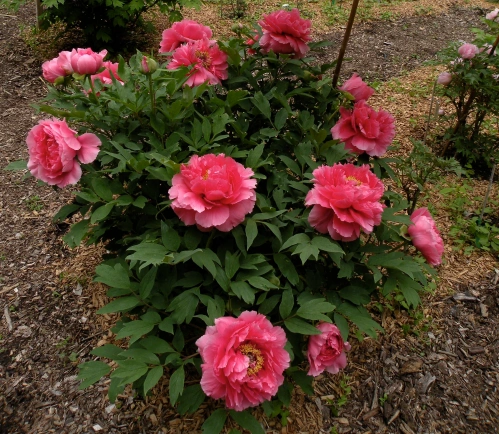
Coral Terrace 珊瑚台 Shan Hu Tai Chinese tree peony
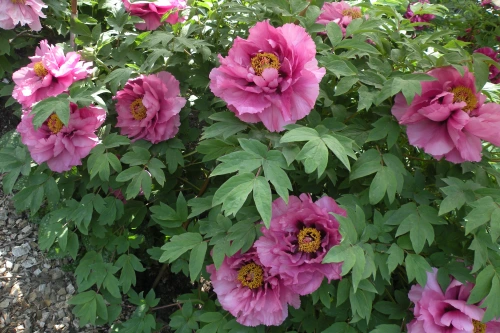
Big Deep Purple 大棕紫 Da Zong Zi Chinese tree peony
Species Herbaceous Peonies
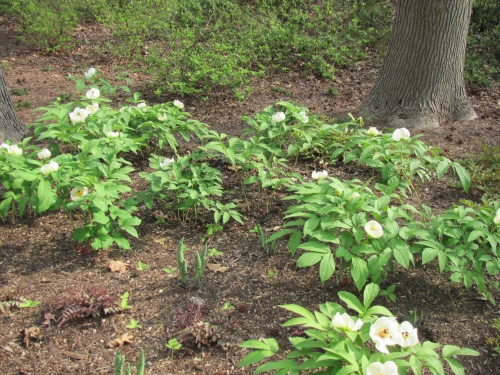
P. japonica remains a small plant even at maturity. This photo was taken at the New York Botanical Garden.
There are approximately 25 species of herbaceous peonies which can be found in the wild over a wide swath of Eurasia, from the Mediterranean to Japan. They are lower growing plants, between 1 to 2.5 ft. tall. Some species, like P. japonica, remain small plants which will not exceed more than 1.5 ft. wide. Others, like P. macrophylla will become large clumps with time, up to 3 ft. wide.
Landscape use: Some species, like P. japonica are ideal for the shady margin between the deciduous forest and the garden. Other species require full sun. All add delicate color to the early spring garden. Be aware that many species peonies will have their foliage die back in the heat of summer.
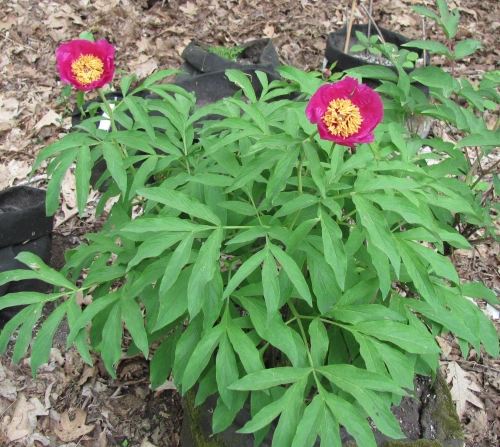
P. officinalis, this central Asian species of herbaceous peony will reach 20 inches tall and form a large spreading clump when mature.
Lactiflora type Herbaceous Peonies
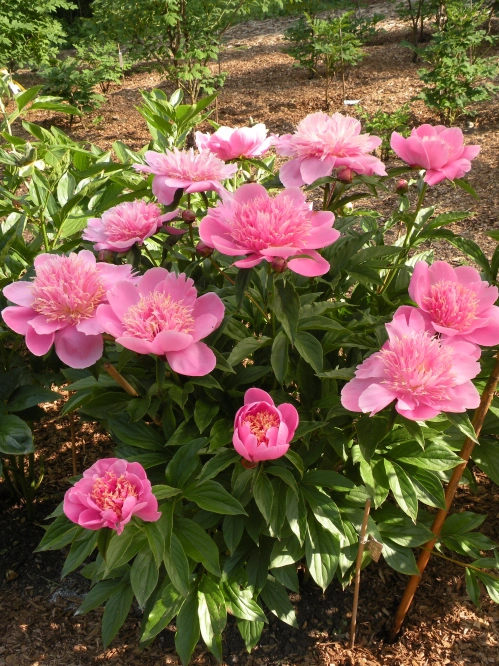
Varieties of P. lactiflora account for many of the best known herbaceous peonies. This particular one is a Cricket Hill Garden seedling.
Cultivated varieties of P. lactiflora account for the vast majority of herbaceous peonies in commerce. This species, which is native to China, forms a tall, upright bush, generally 3.5 ft. tall and wide. Some are single form flowers, while others are fully double form. Some cultivars are weak stemmed and require support, while others have markedly stronger stems. We have test grown more than 150 herbaceous peony cultivars in 25 years and have discarded many because their stems are too weak. We select out the better peonies to propagate and sell, those with vigor and good stems, fragrance, unique form and color.
Landscape uses: Devoted beds or borders. A widely adaptable garden favorite for generations, used in mixed perennial borders with at least six hours of sunlight, to a full day of sun. Will grow in USDA zones 3-8. Some herbaceous peonies will grow and bloom in zone 9, but must be planted just below the soil surface. Difficult to establish in zone 9 due to dryness and lack of winter dormancy.

Some cultivars of P. lactiflora herbaceous peonies were selected for flower size alone. Sarah Bernhardt has a tendency to droop down. They make excellent cut flowers but are less desirable for landscape plantings.
Hybrid Herbaceous Peonies
Hybrid herbaceous peonies are the result of crosses between different peony species. Sizes within this broad group are quite variable, between 2.5-4.5’ tall and 2.5-3.5’ wide. Many of these hybrids were first created in America, in the mid-t0-late 20th century.
Landscape uses: The wide range of flowering times and diverse plant habit make these widely adaptable landscape plants. Many of the new hybrids have been selected with an eye for stunning flowers as well as good stem strength. Used in mixed perennial borders with at least six hours of sunlight, to a full day of sun. Will grow in USDA zones 3-8. Some herbaceous peonies will grow and bloom in zone 9, but must be planted just below the soil surface. Difficult to establish in zone 9 due to dryness and lack of winter dormancy.
Intersectional or ‘itoh’ hybrid peonies
These are hybrids between tree and herbaceous peonies. Well formed bushes grow to 3-4 ft. tall and wide.
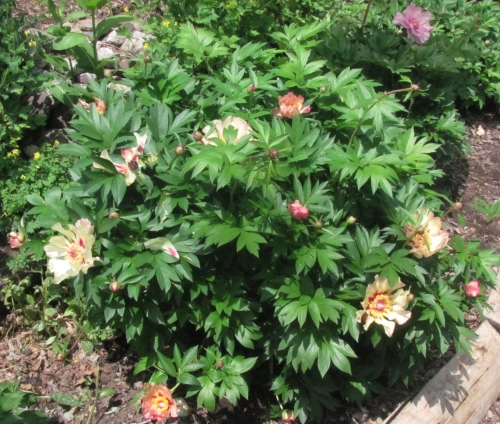
‘Court Jester’ intersectional peony
Landscape uses: Well suited for mixed perennial borders or foundation plantings. The plants require 6 hours or more of sunlight. The foliage is attractive from early spring to the hard frost. The foliage will die back in late autumn and is cut down, to re-emerge in the spring. Clumps get larger over time. For USDA zones 4-9.


